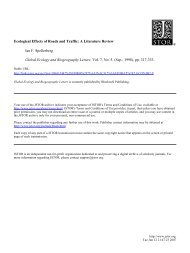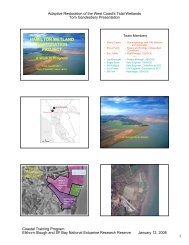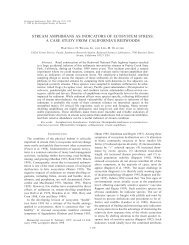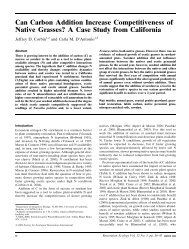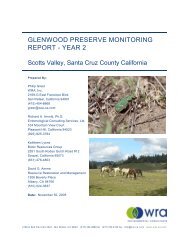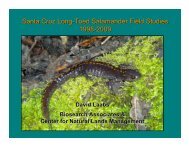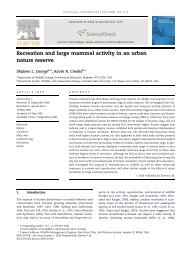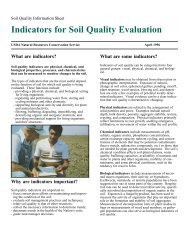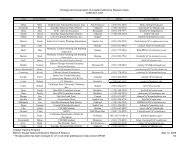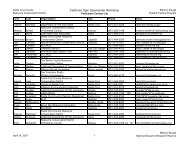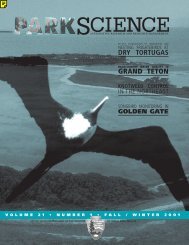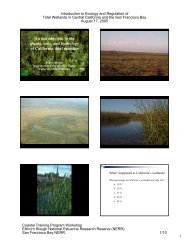NIRANJAN DAS AND SUJATA DEORIpopulation which appears to be declining owingto extensive habitat loss and persistentpersecution.LESSER ADJUTANT (Leptoptilos javanicus) —Vulnerable. Small numbers of this species areresident, mainly in marshes along the Jia-Bharelli River. Six nests were located on a‘Simul’ (Bombax ceiba) tree near Bogijuli Nala inthe eastern region of the park in 2000-2001. Thisstork has a small population which is rapidlydeclining, in particular as a result of huntingpressure.SUMBA BUTTONQUAIL (Turnix everetti) —Vulnerable. This elusive grassland specialistqualifies as Vulnerable on the grounds that itssmall range (where it is known from few locations)and single population are likely to bedeclining as a result of habitat degradation. Oneindividual was seen in the grassland near the confluenceof Doigrung River on 13th March 2000.YELLOW-LEGGED PIGEON (Columbapallidiceps) — Vulnerable. This species hasundergone a considerable decline in numbersover the last century. A pair was seen in a Jamuk(Syzygium fruticosum) tree near the secondaryforest in Owbari area. Now it has a smallpopulation, fragmented and likely to be indecline owing to forest loss.GREY HEADED WOODPECKER (Picuscanus) — Threatened. The Grey-headedWoodpecker, also known as the Grey-facedWoodpecker, is a resident in leaf forests andmixed forests. Three birds were seen on 24thJune 1999 near the high forest borderingsouthern edge of Pakhui Wildlife Sanctuary ofArunachal Pradesh.BLACK-BELLIED TERN (Sterna acuticauda) —Near-Threatened. This rare species wasobserved at Potasali on the Jia-Bhareli River(two on 5 February, two on 2 March 2000 andone on 7 November 2001) amidst groups ofRiver Terns (Sterna aurantia). Breeding has notbeen observed in the area and the species’seasonal status is unclear.LESSER FISH EAGLE (Ichthyophaga humilis)— Near-Threatened. This species is rare, andpresumably resident. One was seen soaring overwoodland along the Nameri River on 13February 1998. Dymond (1998) recorded one atPotasali on 25–27 November in the same year.GREAT HORNBILL (Buceros bicornis) — Near-Threatened. Although this species has a largerange, it occurs at low densities and is patchilydistributed. Three birds were observed flyingsouth along the Dinai River in primary forest on12 December 2001. Probably they were flyingfrom Pakhui Wildlife Sanctuary towards highforest Bhelu (Tetrameles nudiflora) in the park. Itis likely to be declining moderately rapidlythroughout its range.GREY-HEADED FISH EAGLE (Ichthyophagaichthyaetus) — Near-Threatened. This species isthought to be undergoing a moderately rapidpopulation reduction owing to habitatdegradation, pollution and over-fishing. Onewas seen with Ruddy Kingfisher (Halcyoncoromanda) along the bed of Jia-Bhorelli Rivernear Potasali camp on 17th May 2002. Althoughwidespread, it is now only locally common.ORIENTAL DARTER (Anhinga melanogaster)— Near-Threatened. This species’ population isdeclining rapidly owing to pollution, drainage,hunting and collection of eggs and nestlings. Apair was seen in the B<strong>org</strong>huli wetland on 19thDecember 2000.BROWN FULVETTA (Alcippe brunneicauda) —Near-Threatened. This species is found insubtropical or tropical moist low land forests. Itis threatened by habitat destruction. One wasseen in the dry grassland area near NameriRiver on 13th March, 2003.CONCLUSIONSThis is the second ornithological survey ofNameri National Park. Further work shouldfocus on systematic surveys for White-wingedWood Duck in order to determine its populationsize in the park. Fragmentation of forests in thisregion has led to the park becoming increasinglyinsular, and landscape-level studies are neededto investigate the effect of habitat fragmentationon the park’s avifauna.REFERENCESBARTHAKUR, M. 1986. Weather and climate of NortheastIndia. North-Eastern Geographer 18: 31-32.BARUA, M., AND P. SHARMA. 1999. Occurrence of theHill Blue Flycatcher (Cyornis banyumas) in NameriNational Park, Assam. Newsletter forBirdwatchers 39: 61–62.<strong>BIRD</strong> LIFE INTERNATIONAL. 2004. Threatened Birds ofthe World 2004. CD-ROM. Bird Life International,Cambridge, U.K.[42]
<strong>BIRD</strong>S OF NAMERI NATIONAL PARKCHAMPION, H.G., AND S.K. SETH. 1968. A revisedSurvey of the forest types of India. Government ofIndia Publications, New Delhi.DATTA, A., P.SINGH, R.M. ATHREYA, AND S.KARTHIKEYAN. 1998. Birds of Pakhui WildlifeSanctuary in western Arunachal Pradesh, NorthEast India. Newsletter for Birdwatchers 38: 39-43.DYMOND, N. 1998. List of Birds seen in NameriNational Park: 25–27 November 1998.Unpublished Trip Report.HENDRIKS, H. 1998. Birds seen in North-Eastern India.Unpublished Trip Report.ISLAM, M.Z., AND A.R. RAHMANI. 2002. Threatenedbirds of India. Buceros 7: 1–2.MYERS, N. 1988. Threatened biotas: ‘hotspots’ intropical forests. Environmentalist 8: 18-20.RAHMANI, A. R., G. NARAYAN, L. ROSALIND, AND R.SANKARAN. 1990. Status of Bengal Florican in India.Pp. 55–78 in Status and Ecology of the Lesser andBengal Floricans, with reports on Jerdon’s Courserand Mountain Quail: Final Report. BombayNatural History Society, Mumbai.PENHALLURICK, J. 2001. Birds seen in Assam duringApril 2001. Unpublished field notes.ROBSON, C. 2004. From the field. Birding Asia 1: 78–87.SINGH, P. 1991. Avian and mammalian evidences inPakhui Wildlife Sanctuary in East KamengDistrict, Arunachal Pradesh. Arunachal ForestNews 9: 1–10.SINGH, P. 1994. Recent bird records from ArunachalPradesh. Forktail 10: 65–104.TALUKDAR, B.K. 1997. Record of largest Flock of GreatCormorant in Nameri Wildlife Sanctuary, Assam.Newsletter for Birdwatchers 37: 65.TALUKDAR, B.K. AND R.K. DAS. 1997. Record of birdsof prey in Nameri Wildlife Sanctuary, Assam.Newsletter for Birdwatchers 37: 50–51.[43]
- Page 1 and 2: BIRD POPULATIONSA journal of global
- Page 3 and 4: BIRD POPULATIONSA journal of global
- Page 6 and 7: ROBERT L. WILKERSON AND RODNEY B. S
- Page 8 and 9: ROBERT L. WILKERSON AND RODNEY B. S
- Page 10 and 11: ROBERT L. WILKERSON AND RODNEY B. S
- Page 12 and 13: ROBERT L. WILKERSON AND RODNEY B. S
- Page 14 and 15: ROBERT L. WILKERSON AND RODNEY B. S
- Page 16 and 17: ROBERT L. WILKERSON AND RODNEY B. S
- Page 18 and 19: ROBERT L. WILKERSON AND RODNEY B. S
- Page 20 and 21: ROBERT L. WILKERSON AND RODNEY B. S
- Page 22 and 23: ROBERT L. WILKERSON AND RODNEY B. S
- Page 24 and 25: ROBERT L. WILKERSON AND RODNEY B. S
- Page 26 and 27: ROBERT L. WILKERSON AND RODNEY B. S
- Page 28 and 29: ROBERT L. WILKERSON AND RODNEY B. S
- Page 30 and 31: ROBERT L. WILKERSON AND RODNEY B. S
- Page 32 and 33: ROBERT L. WILKERSON AND RODNEY B. S
- Page 34 and 35: ROBERT L. WILKERSON AND RODNEY B. S
- Page 36 and 37: ROBERT L. WILKERSON AND RODNEY B. S
- Page 38 and 39: ROBERT L. WILKERSON AND RODNEY B. S
- Page 40 and 41: NIRANJAN DAS AND SUJATA DEORIincluy
- Page 42 and 43: NIRANJAN DAS AND SUJATA DEORIprovid
- Page 46 and 47: NIRANJAN DAS AND SUJATA DEORITABLE
- Page 48 and 49: NIRANJAN DAS AND SUJATA DEORITABLE
- Page 50 and 51: NIRANJAN DAS AND SUJATA DEORITABLE
- Page 52 and 53: NIRANJAN DAS AND SUJATA DEORITABLE
- Page 54 and 55: NIRANJAN DAS AND SUJATA DEORITABLE
- Page 56 and 57: NIRANJAN DAS AND SUJATA DEORITABLE
- Page 58 and 59: Bird Populations 10:56-64© The Ins
- Page 60 and 61: WETLAND BIRDS OF GHANAAvicennia afr
- Page 62 and 63: WETLAND BIRDS OF GHANATABLE 1. Data
- Page 64 and 65: WETLAND BIRDS OF GHANATABLE 2: Esti
- Page 66 and 67: WETLAND BIRDS OF GHANAATTUQUAYEFIO,
- Page 68 and 69: JANNIK HANSEN, LARS HOLST HANSEN, N
- Page 70 and 71: JANNIK HANSEN, LARS HOLST HANSEN, N
- Page 72 and 73: JANNIK HANSEN, LARS HOLST HANSEN, N
- Page 74 and 75: JANNIK HANSEN, LARS HOLST HANSEN, N
- Page 76 and 77: JANNIK HANSEN, LARS HOLST HANSEN, N
- Page 78 and 79: JANNIK HANSEN, LARS HOLST HANSEN, N
- Page 80 and 81: JANNIK HANSEN, LARS HOLST HANSEN, N
- Page 82 and 83: JANNIK HANSEN, LARS HOLST HANSEN, N
- Page 84 and 85: JANNIK HANSEN, LARS HOLST HANSEN, N
- Page 86 and 87: JANNIK HANSEN, LARS HOLST HANSEN, N
- Page 88 and 89: JANNIK HANSEN, LARS HOLST HANSEN, N
- Page 90 and 91: BIRD POPULATIONSA journal of global
- Page 92 and 93: Bird Populations 10:90-109© The In
- Page 94 and 95:
DAVID J. ZIOLKOWSKI JR., KEITH L. P
- Page 96 and 97:
DAVID J. ZIOLKOWSKI JR., KEITH L. P
- Page 98 and 99:
DAVID J. ZIOLKOWSKI JR., KEITH L. P
- Page 100 and 101:
DAVID J. ZIOLKOWSKI JR., KEITH L. P
- Page 102 and 103:
DAVID J. ZIOLKOWSKI JR., KEITH L. P
- Page 104 and 105:
DAVID J. ZIOLKOWSKI JR., KEITH L. P
- Page 106 and 107:
DAVID J. ZIOLKOWSKI JR., KEITH L. P
- Page 108 and 109:
DAVID J. ZIOLKOWSKI JR., KEITH L. P
- Page 110 and 111:
DAVID J. ZIOLKOWSKI JR., KEITH L. P
- Page 112 and 113:
Bird Populations 10:110-113© The I
- Page 114 and 115:
THE 2007 AND 2008 NORTH AMERICAN BR
- Page 116 and 117:
Bird Populations 10:114-124© The I
- Page 118 and 119:
BREEDING BIRD CENSUS: 2007on the pl
- Page 120 and 121:
BREEDING BIRD CENSUS: 2007May, with
- Page 122 and 123:
BREEDING BIRD CENSUS: 2007Remarks:
- Page 124 and 125:
BREEDING BIRD CENSUS: 200717. PITCH
- Page 126 and 127:
BREEDING BIRD CENSUS: 2007+; Wester
- Page 128 and 129:
BREEDING BIRD CENSUS: 2008gray Gnat
- Page 130 and 131:
BREEDING BIRD CENSUS: 2008Warbler,
- Page 132 and 133:
BREEDING BIRD CENSUS: 2008Source: W
- Page 134 and 135:
BREEDING BIRD CENSUS: 2008Spotted T
- Page 136 and 137:
BREEDING BIRD CENSUS: 2008precipita
- Page 138 and 139:
Bird Populations 10© The Institute
- Page 140 and 141:
IS AVIAN BREEDING SUCCESS WEATHERIN
- Page 142 and 143:
IS AVIAN BREEDING SUCCESS WEATHERIN
- Page 144 and 145:
DAVE LEECH AND CARL BARIMOREFlycatc
- Page 146 and 147:
Bird Populations 10:143-145Reprinte
- Page 148 and 149:
WOODPIGEON JOINS THE GARDEN PREMIER
- Page 150 and 151:
CHANGING THE GUARD AT UK BIRDTABLES
- Page 152 and 153:
Bird Populations is an entirely ele
- Page 154:
BIRD POPULATIONSA journal of global



